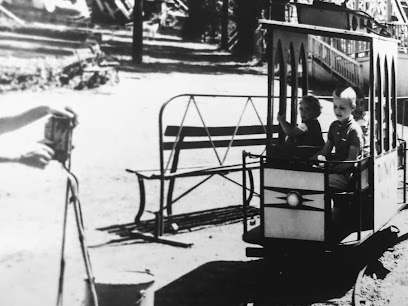The folks who really knew me early on said that I took after the McCloskey side of family, especially
in the looks, that I took after my grandfather, William McCloskey. This clan originally hailed from the
Johnstown, Pa area. We had relatives who died in the Johnstown Flood and who fought for the Union at
Gettysburg. My grandfather and his wife Mary Pearl Angus McCloskey had two daughters: my mother
Elmina and her older sister Evelyn. Together the two McCloskey girls would go on to bear 12 girls and
two boys. I suspect the reason everyone in this clan said I resembled my grandpa was because I was a
male.
 |
| From left to right: Auntie Evelyn Lawrence, Sharon Lawrence, Grandma McCloskey, Elmina Petras |
Anyhow, every summer my Uncle Ray and Aunt Evelyn loaded up their bus (they had ten of the 14
 |
| Safely landed, with sister Elaine as navigator. |
During my kiddy ride days, my Aunt Evelyn was still a few kids shy of having a full battalion.
“Auntie,” by the way, is a term of endearment of the mountain folk of Pennsylvania Dutch. On the Petras—Slovak—side we always said “Aunt.”
 |
| Judy and I sharing a boat at Rock Springs |
The kiddie rides at Rock Springs were especially memorable, thanks to my family’s passing down tales through the generations of the horrors that had befallen them at Johnstown. And it all started because of an earthen dam upstream constructed by rich people, like Andrew Carnegie and Henry Clay Frick. Because of this catastrophe, my mom never trusted anything put together by man. When we rode the tethered airplanes at Rock Springs, Mom expressed her concerns that their cables would snap and fling us back to Johnstown. Mom equally voiced her fears that the kiddie boats would sink and we would drown like Great Aunt Auntie Suzanne Buck, the kiddie cars would crash and give you seven kinds of whiplash. As far as the mammoth wooden wonder, the Cyclone Roller Coaster went, you could get stampeded to the size of an Amish throw rug just by standing in line.
Probably the kiddy ride I remember the most in my kiddy days was the Ferris wheel. Rock Springs smelled like buttered popcorn and cotton candy. And I could smell these sweet aromas as I wheeled around and around, listening to the calliope of the merry-go-round and the laughter and screams on the big boy rides. Suddenly I stopped wheeling around and my carriage, with me still inside it, stopped at the tip top. And I started thinking about Great Auntie Suzanne, how she clung on to that tree branch until her Pennsylvania Dutch grip let go and she was swept away with the raging Little Conemaugh River, and I started trembling and my trembling started rocking the carriage, and I let out a scream, but returned to earth safely, more mature from the firsthand experience, bearing my park souvenir of electrified white hair.
 |
| At the top left is our tethered airplane right before its cable snapped and flung us to Johnstown. |
 |
| The tethered planes platform. sometimes known as the launch pad |
A few years later, I did not think girls were so dumb, just those I was related to. Near the end of the
I really can’t remember any more memorable experiences at Rock Springs after my tunnel-of-love summer. I remember becoming self-conscious about pimples and nose hair and tattle tell sisters. But the wildest amusement ride of all is life itself, and my wife Debbie (Minor) and I had our first born, a girl, of course, in 1976. Most everyone says Severine looks like me; so she must take after the McCloskey side of the family in the looks department, but not the Johnstown fears. She, together with our son and their spouses-- Felipe and Brandie --have four girls and two boys. I believe it’s a good time to endear these beautiful women in the family by calling them Auntie.
We have enough in the family now to participate in a good go at bumper cars.
Rock Springs Park closed in 1970, the year before I graduated from Toronto High School. But every once in a while every summer I go back to Rock Springs for a spin or two in the front car of my memories.
 |
| Moments before derailment |
 |
| My last time on a Ferris wheel--ever |





